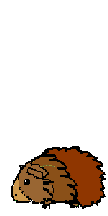The Guinea Pig Arcade &
Crazy Cavy Fun House
home of the one and only

Kissing Cousins
Cavies and Guinea Pigs and Maras
There are 18 species in this family including maras, cavies, and guinea pigs. They are all found in South America.
One species, the lesser capybara, is found in Panama in Central America.
They are found in a variety of habitats including mountains, grasslands, andwetlands. Most species live in groups in burrows and are active during the day. They are herbivores. Cavies and guinea pigs look similar. They have rounded bodies, short legs, large heads, no tails, and short necks. Maras look like a little bit like hares. They have long legs, and their rear legs are longer than their front legs.
-
Brazilian Guinea Pig - Cavia aperea
-
Shiny Guinea Pig - Cavia fulgida
-
Santa Catarina's Guinea Pig - Cavia intermedia
-
Greater Guinea Pig - Cavia magna
-
Montane Guinea Pig - Cavia tschudii
-
Patagonian Mara - Dolichotis patagonum
-
Conejo Del Palo - Dolichotis salinicola
-
Yellow-toothed Cavy - Galea flavidens
-
Muenster Yellow-toothed Cavy - Galea monasteriensis
-
Common Yellow-toothed Cavy - Galea musteloides
-
Spix's Yellow-toothed Cavy - Galea spixii
-
Capybara - Hydrochoerus hydrochaeris
-
Lesser Capybara - Hydrochoerus isthmius
-
Acrobatic Cavy - Kerodon acrobata
-
Rock Cavy - Kerodon rupestris
-
Southern Mountain Cavy - Microcavia australis
-
Andean Mountain Cavy - Microcavia niata
-
Shipton's Mountain Cavy - Microcavia shiptoni


















